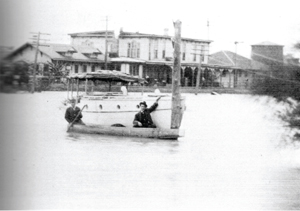
The 1913 flood of the Brazos River was devastating. The water was so high that large boats went up to the Union Depot.
A LITTLE PIECE OF HISTORY | By Joan Frances | Photos from Pictorial History of Rosenberg –
Texans have an answer when people ask about the weather. “If you don’t like the weather today, just stick around. It will change.” South Texas has a reputation for mild winters and hot, muggy summers. Because of its geographical location, the weather is volatile and erratic. South Texas weather history reveals everything from snow and ice, droughts and wildfires to damaging hurricanes that destroy life and the state’s heritage.
Texas’ founding fathers were devoted weather observers. Thomas Jefferson purchased a thermometer and later a barometer to keep a close watch on temperature and weather changes. He participated in appropriating the first known weather observations in America. Records of significant weather events in Texas were documented as early as 1776. Even though basic meteorological instruments had been around for over 100 years, it was the telegraph that advanced the system of informing the public of weather shifts and temperatures during the early and mid 1800s. In 1849, the Smithsonian Institution created weather maps.
Over the past 100 years, South Texas has experienced every type of extreme weather possible. In February 1895, 15 to 20 inches of snow fell in the cities of Houston, Orange, Stafford and Columbus and throughout parts of Fort Bend and Colorado counties, destroying all vegetable crops. On December 24th through December 26, 2004, the first white Christmas in the area was recorded with four inches of snow in Galveston and Houston and 12 inches in Victoria.

Muddy roads hindered early travel in downtown Rosenberg, as evident in this view of Main Street in the early 1900s.
Extreme drought occurred in 1956 and again in January 2001, and $125 million in damage was recorded. A Presidential Disaster Declaration was approved to assist struggling farmers. The most destructive wildfire in Texas history occurred from September to October 2011 in Bastrop County. High winds and downed power lines contributed to the Bastrop County complex fire consisting of three fires that merged into a single blaze east of the city on September 4th. The fire devastated 1,691 homes and a large area of Bastrop State Park at a cost of $325 million. It was finally extinguished on October 29th.
The most common extreme weather pattern in South Texas is the threat of hurricanes. History continues to repeat itself every five to 10 years with a hurricane making landfall, generating damaging winds and flooding. On September 8, 1900, the “Great Galveston Storm” was the worst natural disaster in United States history in terms of loss of life. Storm tides reached 15 feet or more, and property damage was estimated at $30 to $40 million. The exact number was never confirmed, but it was estimated that 6,000 to 10,000 people lost their lives in the storm.
Isaac Monroe Cline, chief of the United States Weather Service Bureau in Galveston, lived through the disaster, but tragically, his pregnant wife disappeared beneath waging flood waters. After the catastrophe, Cline spent most of his focus studying the science of tropical cyclones. The book Isaac’s Storm by Erik Larson chronicled the events of this historical natural disaster and Cline’s heartbreaking loss. Obvious mistakes were made prior to those fateful days. Improvements, were implemented, and a seawall was built to lessen the flood threat during weather disasters.
In the early days, cities in Fort Bend were not equipped to handle droughts and flooding. Most farmers could not afford irrigation facilities, and lack of water meant crop loss and bankruptcy. When the rains came, flooding was a problem with residents living on the Brazos River, forcing them to move to higher ground. The town of Rosenberg was nicknamed “The City of Mud,” where downtown was impossible to travel through until the roads dried.
Today, society has learned from the mistakes of their ancestors. State-of-the-art weather technology continues to keep residents well-informed and safe during natural disasters.